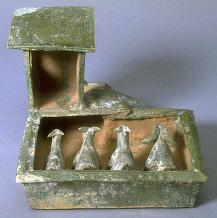| return
to Ford Library and Museum homepage |
|
Han
(206 BC – AD220)
|
| next |
|
The
fatiguing pace of life during the Ch’in prompted civil war and the
downfall of the empire when those who ruled were overthrown by those they
ruled. The victors named their dynasty the Han. |
| back |
|
| Shang
(1523-1027 BC) |
|
| Chou
(1027-221 BC) |
|
| Ch'in
(221-206 BC) |
|
Its
first Emperor, Kao-ti, established his capital at Chang-an. There he set
about replacing the old laws with the teachings of Confucianism, which were
to instruct and edify society. Reaching back to the Chou, the Emperor also
revived the tenant of the Mandate of Heaven, justifying his authority in
the celestial sphere. |
| Three
Kingdoms (220-581) |
|
| Sui
(581-618) |
|
| T'ang
(618-907) |
|
| Sung
(907-1279) |
|
| Yüan
(1279-1368) |
|
In
the early years of Han, government became less oppressive. Taxes were lowered
and extreme punishment curtailed. Merchants, a class generally distrusted,
gained new freedoms, and as the floods of the Yellow River were better controlled,
more land was brought under plow. Internal disputes subsided and efforts
were made to appease the barbarians of the north and west. Over time China’s
borders swelled, reaching well beyond the Yellow and Yangtze Rivers. By
87 BC much of what is now modern China was under Han’s direct rule.
The emperor governed well over a million square miles and a population of
almost fifty million, an empire comparable in almost every way to that of
contemporary Rome. |
 |
| Ming
(1368-1644) |
| Ch'ing
(1644-1912) |
| Opening
the Door (1844-1911) |
| The
Period of Revolution (1912-1949) |
| Mao's
Dynasty (1949-1976) |
| Raising
the Bamboo Curtain (1972-1979) |
|
Model
of Goat Pen
c. 206 BCE - c. 220 AD
Han Period
red pottery with green-lead glaze
7 in. x 8 1/2 in. x 7 1/2
Courtesy The University of Michgan
Art Museum |
| Into
the Next Millennium (1979- ) |
|
| |
|
| |
|
| |
|
| Such
aggressive expansion came at a cost, however, and the country found its
many resources strained. Measures were undertaken to give greater authority
to regional officials, and a professional army replaced the army of conscripted
peasants. |
| This
new army was tested by unrest on the borders, as outlying states warred
with the Empire. Also the Yellow River again flooded and, combined with
other natural disturbances, caused many to question the Emperor’s
Heavenly Mandate. These problems forced a migration of peasants southward;
eighteen million or more made the trek in the first two centuries of the
new millennium. Strained by these migrants, the people of the south and
east rebelled, climaxing in AD 220 when the Emperor surrendered his throne
to Ts’ao-P’i, who declared himself the first Emperor of the
Wei Dynasty. Not only had 400 years of Han ended, but the empire it ruled
was split in thirds, each governed by its own emperor. |
